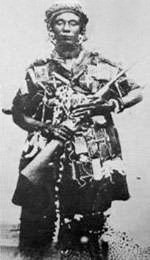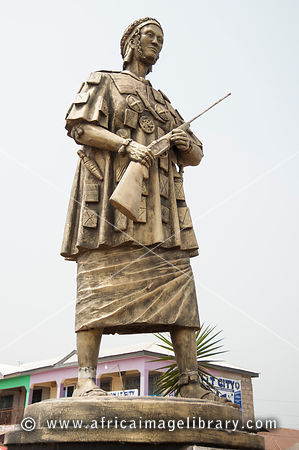يا أسانتىوا
يا أسانتىوا (Yaa Asantewaa ؛ تُنطق /ˈyɑː ɑːsɑːn.teɪ.wə/ ؛ ح. 1840 – 17 أكتوبر 1921) عـُيـِّنت الملكة الأم على إجيسو في امبراطورية أسانتى—التي هي اليوم جزء من غانا—من قِبل شقيقها نانا أكواسي أفرانى أوكپسى، الإجيسوهنى—أو حاكم إجيسو. وفي 1900، قادت تمرد الأسانتى المعروف بإسم حرب الكرسي الذهبي، والمعروف أيضاً بإسم "حرب يا أسانتىوا"، ضد الاستعمار البريطاني.[1]
. . . . . . . . . . . . . . . . . . . . . . . . . . . . . . . . . . . . . . . . . . . . . . . . . . . . . . . . . . . . . . . . . . . . . . . . . . . . . . . . . . . . . . . . . . . . . . . . . . . . . . . . . . . . . . . . . . . . . . . . . . . . . . . . . . . . . . . . . . . . . . . . . . . . . . . . . . . . . . . . . . . . . . . .
ارهاصات التمرد
During her brother's reign, Yaa Asantewaa saw the Asante Confederacy go through a series of events that threatened its future, including civil war from 1883 to 1888. When her brother died in 1894, Yaa Asantewaa used her right as Queen Mother to nominate her own grandson as Ejisuhene. When the British exiled him in the Seychelles in 1896, along with the King of Asante Prempeh I and other members of the Asante government, Yaa Asantewaa became regent of the Ejisu-Juaben District. After the deportation of Prempeh I، الحاكم العام البريطاني لساحل الذهب، فردريك هودجسون، demanded the Golden Stool, the symbol of the Asante nation. This request led to a secret meeting of the remaining members of the Asante government في كوماسي, to discuss how to secure the return of their king. There was a disagreement among those present on how to go about this. Yaa Asantewaa, who was present at this meeting, stood and addressed the members of the council with these now-famous words:
"Now, I see that some of you fear to go forward to fight for our king. If it was in the brave days of Osei Tutu, Okomfo Anokye, and Opoku Ware I, chiefs would not sit down to see their king to be taken away without firing a shot. No European could have dared speak to chiefs of Asante in the way the governor spoke to you this morning. Is it true that the bravery of Asante is no more? I cannot believe it. It cannot be! I must say this: if you, the men of Asante, will not go forward, then we will. We, the women, will. I shall call upon my fellow women. We will fight! We will fight till the last of us falls in the battlefields."[2]
وبذلك، تولت قيادة انتفاضة الأسانتى في 1900، وحصلت على دعم بعض نبلاء الأسانتى الآخرين.
التمرد وأعقابه
Beginning in March 1900, the rebellion laid siege to the fort في كوماسي حيث لجأ البريطانيون. The fort still stands today as the Kumasi Fort and Military Museum. After several months, the Gold Coast governor eventually sent a force of 1,400 to quell the rebellion. During the course of this, Queen Yaa Asantewaa and 15 of her closest advisers were captured, and they too were sent into exile to the Seychelles.[3] The rebellion represented the final war in the Anglo-Asante series of wars that lasted throughout the 19th century. On 1 January 1902, the British were finally able to accomplish what the Asante army had denied them for almost a century, and the Asante empire was made a محمية للتاج البريطاني.
Yaa Asantewaa died in exile in the Seychelles on 17 October 1921. Three years after her death, on 27 December 1924, Prempeh I and the other remaining members of the exiled Asante court were allowed to return to Asante. Prempeh I made sure that the remains of Yaa Asantewaa and the other exiled Asantes were returned for a proper royal burial. Yaa Asantewaa's dream for an Asante free of British rule was realized on 6 March 1957, when the Asante protectorate gained independence as part of Ghana, the first African nation in Subsaharan Africa to achieve this feat.
الأدوار الاجتماعية لنساء الأسانتى
The confrontation of a woman, serving as political and military head of an empire, was foreign to British colonial troops in 19th-century Africa. Yaa Asantewaa's call upon the women of the Asante Empire is based on the political obligations of Akan women and their respective roles in legislative and judicial processes. The hierarchy of male stools among the Akan people were complemented by female counterparts. Within the village, elders known as (mpanyimfo) heads of the matrilineages, constituted with the village council known as the ôdekuro. These women known as the mpanyinfo referred to aberewa or ôbaa panyin, to look after women's affairs. For every ôdekuro, an ôbaa panyin acted as the responsible party for the affairs of the women of the village and served as a member of the village council.
The head of a division, the ôhene, and the head of the autonomous political community, the ômanhene, had their female counterparts known as the ôhemaa: a female ruler who sat on their councils. The ôhemaa and ôhene were all of the same mogya, blood or localized matrilineage. The occupant of the female stool in Kumasi state, the Asantehemaa, and therefore, the united Asante, since her male counterpart was ex-officio of the Asanthene, was a member of the Kôtôkô Council, the Executive Committee or Cabinet of the Asanteman Nhyiamu, General Assembly of Asante rulers. Female stool occupants participated in not only the judicial and legislative processes, but also in the making and unmaking of war, and the distribution of land.[4]
مكان في التاريخ وذكرى ثقافية

تظل يا أسانتىوا a much-loved figure in Asante history and the history of Ghana as a whole for her role in confronting the colonialism of the British. She is immortalized in song as follows:
- Koo koo hin koo
- Yaa Asantewaa ee!
- Obaa basia
- Ogyina apremo ano ee!
- Waye be egyae
- Na Wabo mmode
- ("Yaa Asantewaa
- The woman who fights before cannons
- You have accomplished great things
- You have done well")[5]
To highlight the importance of encouraging more female leaders in Ghanaian society, the مدرسة يا أسانتىوا الثانوية للبنات was established at Kumasi in 1960 with funds from the صندوق غانا التعليمي.
In 2000, week-long centenary celebrations were held in Ghana to acknowledge انجازات يا أسانتىوا. As part of these celebrations, a متحف مخصص لها في كواسو في إجيسو-جوابن، المقاطعة البلدية، في 3 أغسطس 2000. Unfortunately, a fire there on 23 July 2004 destroyed several historical items, including her sandals and battle dress (batakarikese) seen in the photograph above.[6] The current Queen-mother of Ejisu is Yaa Asantewaa II. A second Yaa Asantewaa festival was held 1–5 August 2006, in Ejisu.[7]
The Yaa Asantewaa Centre in Maida Vale, west لندن, is an African-Caribbean arts and community centre.[8] It took its name in 1986.[9]
A television documentary by Ivor Agyeman-Duah entitled يا أسانتىوا - The Exile of King Prempeh and the Heroism of An African Queen was premiered in Ghana in 2001.[10]
A stage show written by Margaret Busby, Yaa Asantewaa: Warrior Queen, directed by Geraldine Connor and featuring master drummer Kofi Ghanaba,[11][12] with a pan-African cast, toured the UK and Ghana in 2001–02.[13][14] A radio drama by the same author was also serialized 13–17 October 2003.[15] on BBC Radio Four's Woman's Hour.[16][17]
للاستزادة
- Ivor Agyeman-Duah, Yaa Asantewaa: The Heroism of an African Queen, Accra, Ghana: Centre for Intellectual Renewal, 1999.
- Nana Arhin Brempong (Kwame Arhin), "The Role of Nana Yaa Asantewaa in the 1900 Asante War of Resistance", Ghana Studies 3, 2000, pp. 97–110.
الهامش
- ^ Appiah, Kwame Anthony، وهنري لويس گيتس، الابن (eds), Africana: The Encyclopedia of the African and African American Experience, p. 276.
- ^ Addy, E. A., Ghana: A History for Primary Schools.
- ^ Berry, L. V., Ghana: a Country Study.
- ^ Arhin, Kwame, "The Political and Military Roles of Akan Women", in Christine Oppong (ed.), Female and Male in West Africa, London: Allen and Unwin, 1983.
- ^ "Yaa Asantewaa", in The Oxford Encyclopedia of Women in World History, 2008, quoting Arhin, p. 97.
- ^ "Fire guts Yaa Asantewaa Museum", GhanaWeb, 25 July 2004.
- ^ Public Agenda (16 January 2006)
- ^ Carnival Village website.
- ^ Dixon, Carol, "Spotlight: April - May 2002 Yaa Asantewaa Arts and Community Centre", Casbah Project.
- ^ Dadson, Pajohn, "Ghana: Yaa Asantewaa Has Landed", AllAfrica, 18 May 2001.
- ^ Wilmer, Val, "Kofi Ghanaba obituary", The Guardian, 7 February 2009.
- ^ Osei Boateng, "Yaa Asantewaa on stage: The Exploits of Yaa Asantewaa, the Warrior Queen of the Asantes in Ghana...", New African, 1 April 2001. The Free Library.
- ^ Busby, Margaret, "Obituary of Geraldine Connor", Guardian, 31 October 2011.
- ^ Duodu, Cameron, "Yaa Asantewaa—Warrior Queen", New African, 1 June 2001. The Free Library.
- ^ "Yaa Asantewaa", RadioListings.
- ^ BBC Radio 4 Promotion Note, Title: YAA ASANTEWAA by Margaret Busby.
- ^ "Briefing: Yaa Asantewaa", The Herald, 13 October 2003.

